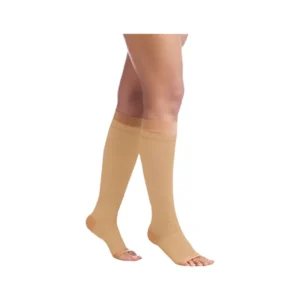Description
Key Features
- Compression Levels
- Available in varying compression strengths, typically measured in mmHg (millimeters of mercury). Common levels include:
- 15–20 mmHg (Mild): For mild swelling, fatigue, or preventative use during travel.
- 20–30 mmHg (Moderate): For varicose veins, moderate edema, or post-surgical recovery.
- 30–40 mmHg (Firm): For severe venous insufficiency, chronic swelling, or lymphedema.
- Available in varying compression strengths, typically measured in mmHg (millimeters of mercury). Common levels include:
- Thigh-Length Design
- Covers the foot, calf, and thigh, ending just below the groin.
- Provides extended compression for the entire lower leg, making it ideal for conditions affecting the upper leg.
- Material
- Made from elastic, breathable fabrics like nylon, spandex, or latex-free materials.
- Often includes moisture-wicking properties to keep skin dry.
- Seamless Construction
- Reduces friction and irritation, enhancing comfort for all-day wear.
- Open/Closed Toe Options
- Closed toe: Full foot coverage for maximum compression.
- Open toe: Allows ventilation and accommodates foot conditions (e.g., bunions).
- Graduated Compression
- Highest pressure at the ankle, gradually decreasing up the leg to promote upward blood flow.
- Silicone Band or Grip Top
- Features a silicone band or grip top at the thigh to prevent slipping.
Benefits
- Improved Circulation: Prevents blood pooling in the legs.
- Reduced Swelling: Alleviates edema caused by prolonged standing, pregnancy, or medical conditions.
- DVT Prevention: Lowers the risk of blood clots during long flights or bed rest.
- Pain Relief: Eases discomfort from varicose veins or chronic venous insufficiency.
- Enhanced Mobility: Lightweight and flexible for daily activities.
Indications for Use
- Chronic venous insufficiency
- Varicose veins or spider veins
- Pregnancy-related leg swelling
- Post-thrombotic syndrome
- Lymphedema
- Post-surgical recovery (e.g., vein procedures)
- Long-distance travel (to prevent DVT)
Contraindications
- Peripheral artery disease (PAD): Compression may reduce already compromised blood flow.
- Skin infections or open wounds: Direct contact could worsen irritation.
- Severe neuropathy: Reduced sensation may prevent detection of improper fit.
Sizing Guide
Proper fit is critical for effectiveness. Measurements typically include:
- Ankle circumference (smallest part above the ankle bone).
- Calf circumference (widest part of the calf).
- Thigh circumference (widest part of the thigh).
- Leg length (heel to the groin).
Prolim stockings often come in sizes like Small, Medium, Large, or Extra-Large, based on these measurements.
How to Use
- Putting On:
- Apply in the morning when swelling is minimal.
- Roll the stocking up to the heel, insert the foot, and gently pull up to the thigh.
- Avoid excessive stretching.
- Removing:
- Peel downward slowly to avoid damaging the fabric.
- Daily Wear:
- Typically worn during the day and removed at night unless otherwise prescribed.
Maintenance Tips
- Washing: Hand-wash with mild soap and air-dry to preserve elasticity.
- Replacement: Replace every 3–6 months or as signs of wear (e.g., stretched fabric) appear.
Prolim Thigh-Length Compression Stockings are a practical solution for managing venous and lymphatic issues. Always consult a healthcare provider to determine the appropriate compression level and ensure proper fit. For specific product details, refer to Prolim’s sizing charts and guidelines.



